Today was meant to be the first Owl Tour of the year – but the weather forecast couldn’t have been much less helpful! It was meant to be cloudy with showers in the morning, becoming heavy at times in the afternoon, and windy with it. Still, we are always up for a challenge and we set off to have a go.
Our first stop was a regular site for Little Owl. The owls like a bit of warmth in the morning air to bring them out, which we didn’t have today, but there was also lots of activity around the farm buildings where the owls like to perch, with a steady stream of tractors back and forth. With the cold and disturbance, we were always likely to be out of luck. We had a drive round the area which produced a nice group of three Grey Partridges in a field by the road. A couple of Brown Hares were hunkered down in a winter wheat field.
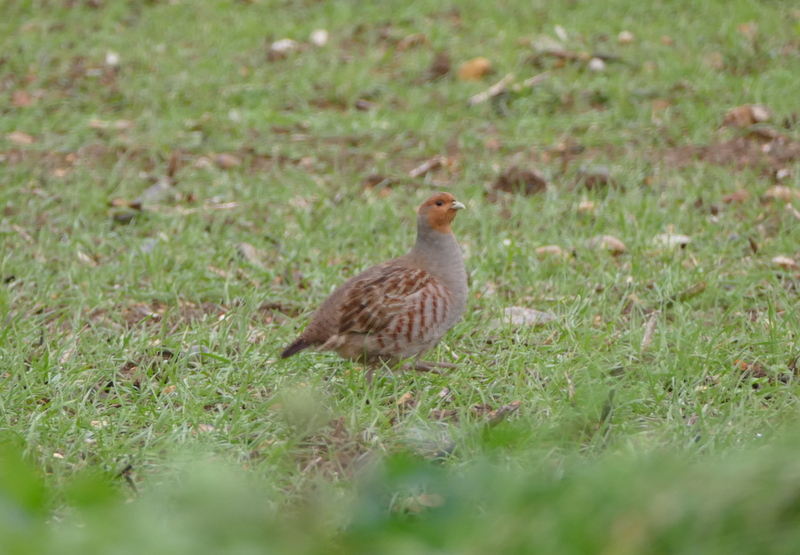 Grey Partridge – three were by the road this morning
Grey Partridge – three were by the road this morning
We meandered our way west inland behind the coast. A Red Kite hung over the field beside the road, eyeing up some roadkill on the tarmac. We stopped off at several sites where we know Barn Owls and Little Owls are around, but the weather was against us. The cloud increased and it started to drizzle. We decided to look for some other birds instead.
We made our way along to Choseley. There have been Rough-legged Buzzards in this area on and off for a couple of months now, but they roam around a large area and can be hard to find. A couple of people were standing by the road looking forlornly out across the fields. We stopped for a scan and caught a brief glimpse of a shape gliding low behind a hedge and landing in the grass. Through the scope, we could just see the head of a Rough-legged Buzzard through the vegetation – it took a while for everyone to be able to see it where it was hiding.
 Rough-legged Buzzard – hiding behind the hedge at Choseley, not a great photo!
Rough-legged Buzzard – hiding behind the hedge at Choseley, not a great photo!
Thankfully it had a fly round and showed us all its best features, hanging in the air above the hedge, before dropping down again. In the air, we could see its white tail with a black terminal band and its very pale underparts with a large black belly patch. That was a much better look!
We dropped down over the ridge to Titchwell next – with the possibility of rain on the way, we thought it would be good to be in the vicinity of some hides just in case. Thankfully the rain never came, but we had a good session out on the reserve anyway.
The feeders by the visitor centre were rather quiet today but a careful scan of the ditch by the main path just beyond quickly produced a Water Rail. It was down in the water in the bottom, below a mesh of loose vegetation, and busy preening. The movement made it easier to get everyone onto it and we had good views through the branches.
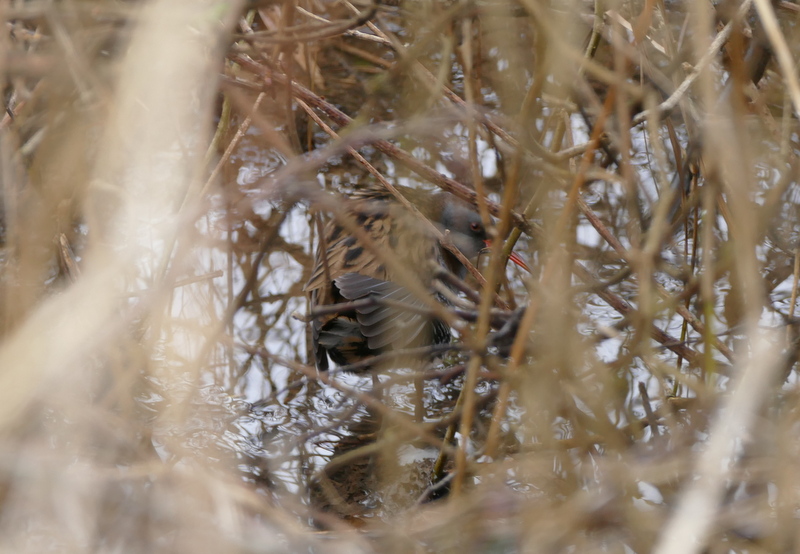 Water Rail – preening in the ditch by the main path
Water Rail – preening in the ditch by the main path
We stopped by the still-drained grazing meadow pool. Three Ringed Plovers, a Dunlin and a Redshank were out on the mud. We really wanted to look through the pipits, but they were flying round all the time and wouldn’t settle in the wind. It started to drizzle again, so we made for the shelter of Island Hide with a view to having another look here later.
The water levels on the freshmarsh have receded a little, but are still very high. We spent some time looking through the ducks and noting their respective ID features. As usual, there were, lots of Wigeon, Teal, Shoveler and Mallard. We paused to admire a pair of Gadwall, noting the delightful intricate plumage detail of the otherwise rather grey drake. Further over, a group of Pintail were mostly asleep on the edge of one of the islands. The flocks of Brent Geese were coming and going as usual, dropping in for a quick bathe before flying back out to the saltmarsh to feed.
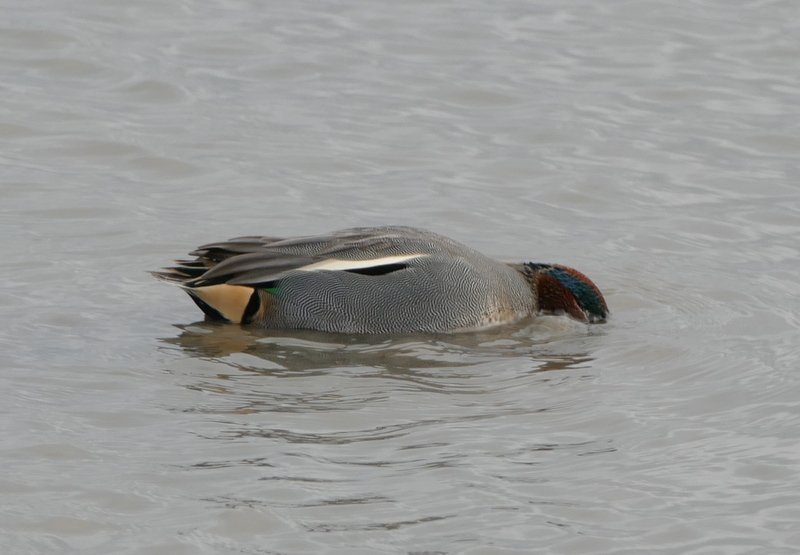 Teal – there are lots of these on the freshmarsh at the moment, busy feeding
Teal – there are lots of these on the freshmarsh at the moment, busy feeding
There is a good number of Avocets on the freshmarsh at the moment. We counted 36 today, an unusually high total for this time of year, possibly reflecting the mild winter weather we have been enjoying up until now. There was also a similarly sized flock of Black-tailed Godwits roosting out in the shallow water. A smattering of Dunlin around the islands were joined by a couple of larger flocks which came in from the direction of the beach.
Suddenly all the waders took to the air and the ducks scattered from the back of the water. Looking through the mass of birds, we could see a Peregrine over the back of the freshmarsh. It turned and stooped down towards the water, sending a small group of Teal flying in all directions, before climbing up again. This time it found itself in the air with a Marsh Harrier and had a quick tussle with it, talons out. Then it turned again and, with wings beating fast, set off after the Teal again. It appeared to be an young bird and presumably an inexperienced hunter because its efforts were wasted and it climbed up again into the sky and drifted over the back towards Brancaster. The Avocets and Black-tailed Godwits were clearly spooked and spent some time swirling round over the water even after it had gone.
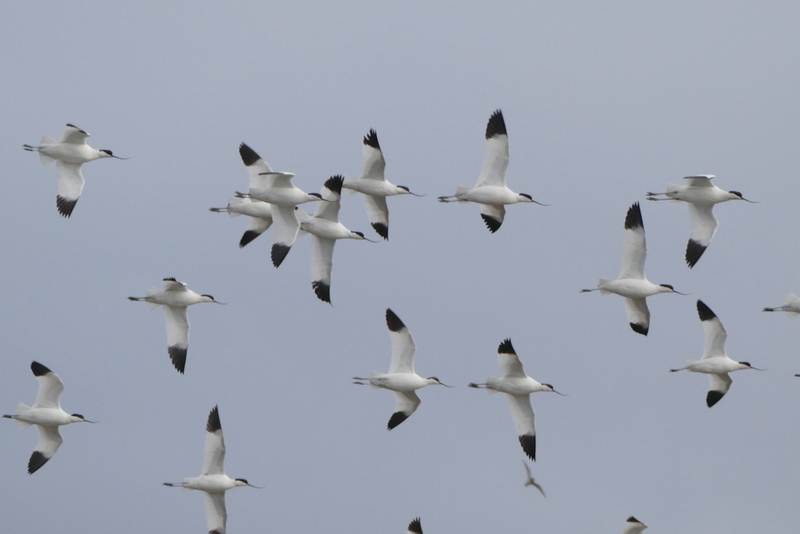 Avocets – swirling round after being spooked by the Peregrine
Avocets – swirling round after being spooked by the Peregrine
We decided to make our way out towards the beach while it wasn’t raining. The Volunteer Marsh held a good selection of waders – the longer we looked, the more we found. We stopped first to look at a Curlew, probing deep into the mud. A couple of Redshank were nearby and a little group of Dunlin dropped in with them. Then a smart spangled Grey Plover appeared in the scope just behind the Curlew. A Ringed Plover and a couple of Knot then ran out into view as well.
 Knot – a few were on the Volunteer Marsh this morning
Knot – a few were on the Volunteer Marsh this morning
The Tidal Pools have been very productive in recent weeks, but when we climbed over the bank along the path today they looked rather empty at first. There were a few Little Grebes diving in the channel and, further back, a couple of female Goldeneye. There were not so many waders on here today, at least partly because the tide was going out and many were on the beach, but the Black-tailed Godwits and Avocets normally on here were obviously part of the respective flocks on the freshmarsh today. However, a careful scan did yield a few rewards. First of all a couple of Ringed Plover were chasing each other around one of the islands close to the path.
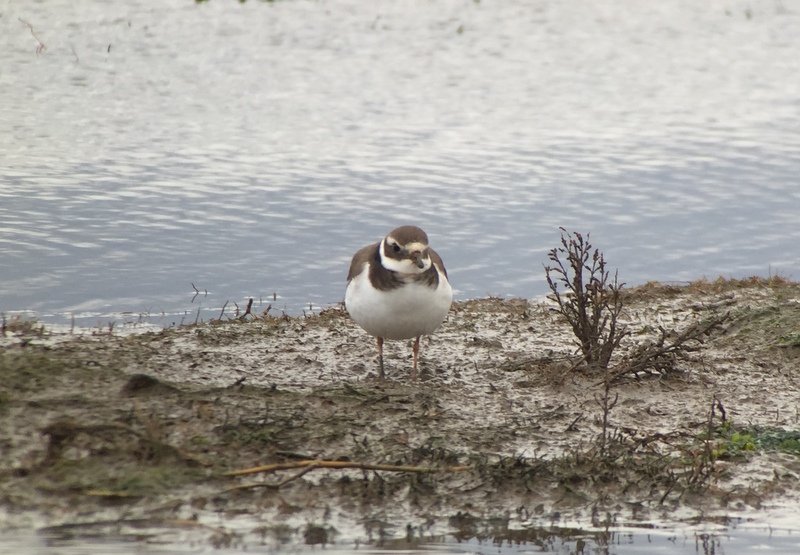 Ringed Plover – one of two on the tidal pools today
Ringed Plover – one of two on the tidal pools today
Then, nearby, we spotted a larger wader – a Bar-tailed Godwit. It was obviously paler than the Black-tailed Godwits we had seen earlier and through the scope we could see it had much more strongly marked upperparts. It was also a little shorter legged and its bill appeared to curve up slightly. It appeared to be injured – it was limping badly – which might have been why it was feeding on here rather than on the beach. Still, it meant we got a very good look at it.
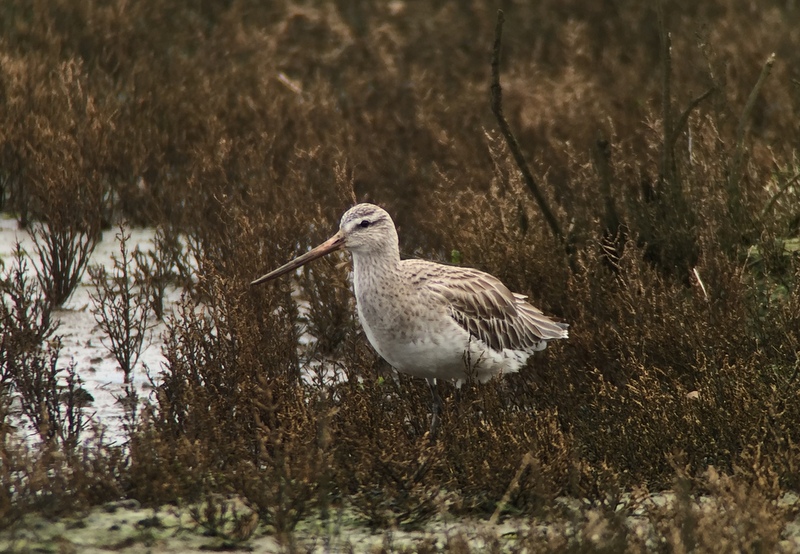 Bar-tailed Godwit – apparently injured, this one was on the tidal pools alone
Bar-tailed Godwit – apparently injured, this one was on the tidal pools alone
Only a little further on, just behind the beach, we came across another Black-tailed Godwit. It was a good opportunity to look again at the differences between these two rather similar species.
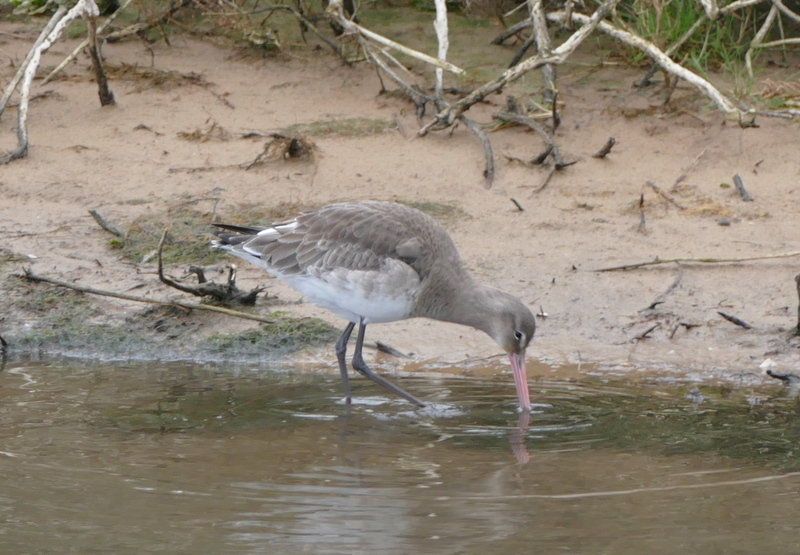 Black-tailed Godwit – just one on the tidal pools today, just behind the beach
Black-tailed Godwit – just one on the tidal pools today, just behind the beach
It was rather exposed on the beach, cold and windy. The shellfish beds were exposed and there were quite a few waders on them – Oystercatchers and Turnstones were both welcome additions to the day’s tally of waders. Running around on the edge of the sand, right over by the sea, was a Sanderling. We had just got it in the scope to admire it when we noticed another Sanderling right at the top of the beach, running around and picking at the line of seaweed which marked the high tide mark – we got a much better look at that one.
There were a few ducks out on the sea. A line of black blobs bobbing about on the waves were Common Scoter, generally the commonest sea duck off here. A few more Goldeneye were scattered in with them. A bit closer in, we spotted a pair of Red-breasted Mergansers, sporting their rather sharp hairdos! We had a quick scan to see if there might be anything else of note out on the water but we couldn’t immediately see anything so we decided to beat a hasty retreat.
On the way back, we stopped again by the grazing meadow ‘pool’. There were lots of Rock Pipits running around on the mud and a careful look through them finally yielded our target – a single Water Pipit. The Rock Pipits were rather swarthy, dull and heavily streaked below, but the Water Pipits much whiter underparts really stood out even at a distance. Then it was back to the car for lunch.
After lunch, the weather had brightened up considerably and the sun even appeared briefly as we started to make our way back east along the coast road. We pulled in quickly at Brancaster Staithe. It was low tide now and there was not much water in parts of the harbour. We had hoped to see the Red-necked Grebe, but it had disappeared further up the channel when we were there. We had to content ourselves with a Greenshank in among the Redshanks. As we looked out west, we could see more dark clouds gathering, so we figured our best chance to find some owls would be to try to stay ahead of them, so we set off again.
We kept our eyes peeled for Barn Owls along the roadside, though it was probably still a bit early at this stage. We pulled in at the west end of Holkham for a scan of the marshes – Barn Owl is always a possibility here, but we ended up alighting upon the Great White Egret instead. It was perched up in the trees at first, though looking a bit unsteady in the wind. After a while it flew down into a patch of wet rushes in front. When it stood up straight, we could see its long neck and long, yellow dagger-shaped bill.
 Great White Egret – on the marshes at the west end of Holkham again today
Great White Egret – on the marshes at the west end of Holkham again today
A little further along the coast road, we made another stop to look at some geese in a wet meadow. There was a small group of White-fronted Geese, mostly sitting down in the grass. The odd one was standing up, giving us a good view of its black belly bars. Nearby was a handful of Pink-footed Geese, so we got those in the scope too for a closer look. Most of the Pink-footed Geese were obviously still out feeding in the sugar beet fields inland, so the majority of the marshes were still rather quiet.
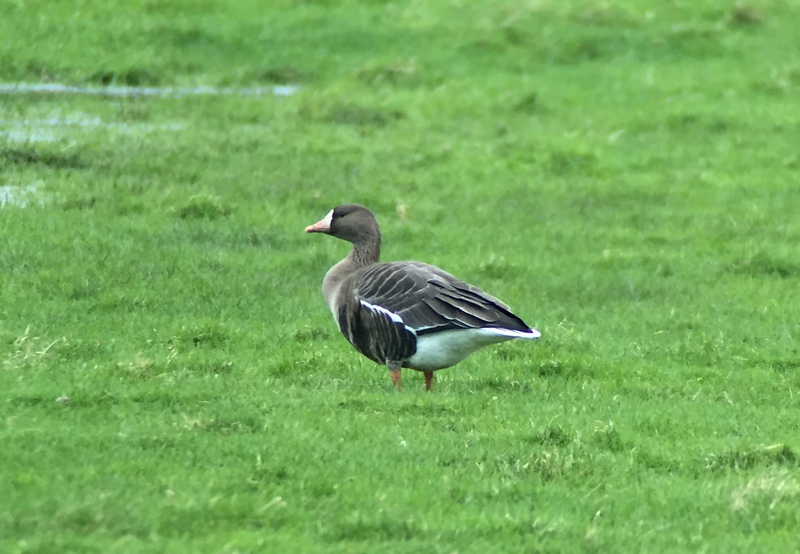 White-fronted Geese – one of a small gaggle by the road at Holkham
White-fronted Geese – one of a small gaggle by the road at Holkham
By now, we were well in the window for a Barn Owl out hunting. We had not seen any around Holkham, so we decided to try to stay ahead of the clouds and continue east. There are several good spots for them along the coast road, and eventually we spotted a white shape in some trees by the road. A strategic reverse into a conveniently placed gateway and we found ourselves finally admiring a Barn Owl.
 Barn Owl – along the coast road this afternoon
Barn Owl – along the coast road this afternoon
It perched for some time looking round, listening to the whirring of the cameras, while we watched it. Eventually it flew down and landed on a fence post a little further away. From there, it stared intently down into the long grass beyond – given the weather, hunting from a sheltered fence post was probably a sensible option. However, it didn’t find anything and eventually we decided to tear ourselves away. As we started the engine again, it dropped down into the grass.
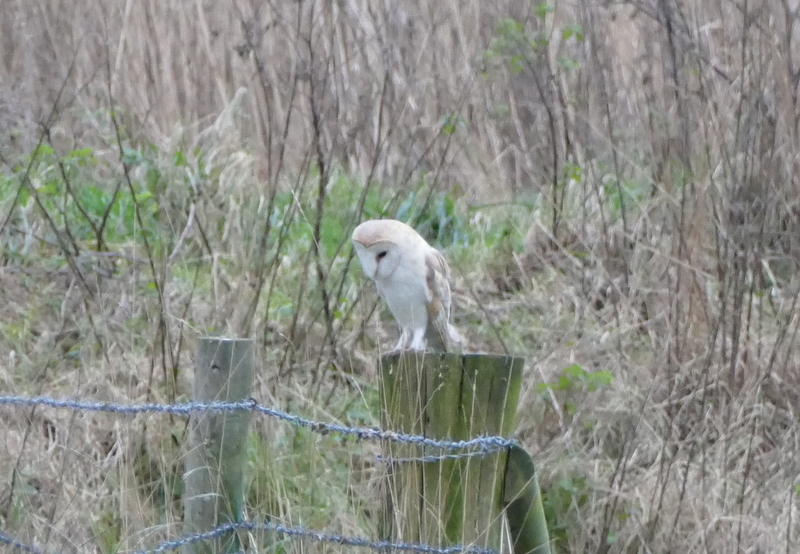 Barn Owl – hoping to find something in the long grass
Barn Owl – hoping to find something in the long grass
We carried on to Blakeney and set off to walk out around the freshmarsh. Unfortunately, the cloud caught up with us again and it started to drizzle lightly once more. It was not very bad, but coupled with the cold and the wind out on the exposed marshes, was presumably enough to put the owls off. We did see another Barn Owl out hunting, distantly over the back, but it just did a quick circuit of one of the fields, perching on a fence post for a few seconds, before heading off inland presumably to find somewhere more sheltered.
We made our way back to the car. We had a short drive around between Wiveton and Cley on our way to our next stop, but the fields here were quiet. Then we stopped by a suitable patch of woodland and waited. The Tawny Owls were a bit slow to get started this evening. About 10 minutes later than usual, one finally started hooting. It gave quite a vocal performance, a mixture of bubbling hoots on and off. Then a second Tawny Owl started up as well, a little further over. We listened to both of them for a while. Unfortunately, it was getting too dark by this stage, just as we reached the time when they start to fly around, and we simply couldn’t make out much through the trees. There are quite a few Tawny Owls in this area, but it was only when we got back to the car that the third began hooting as well. Then it was time to head for home.
















